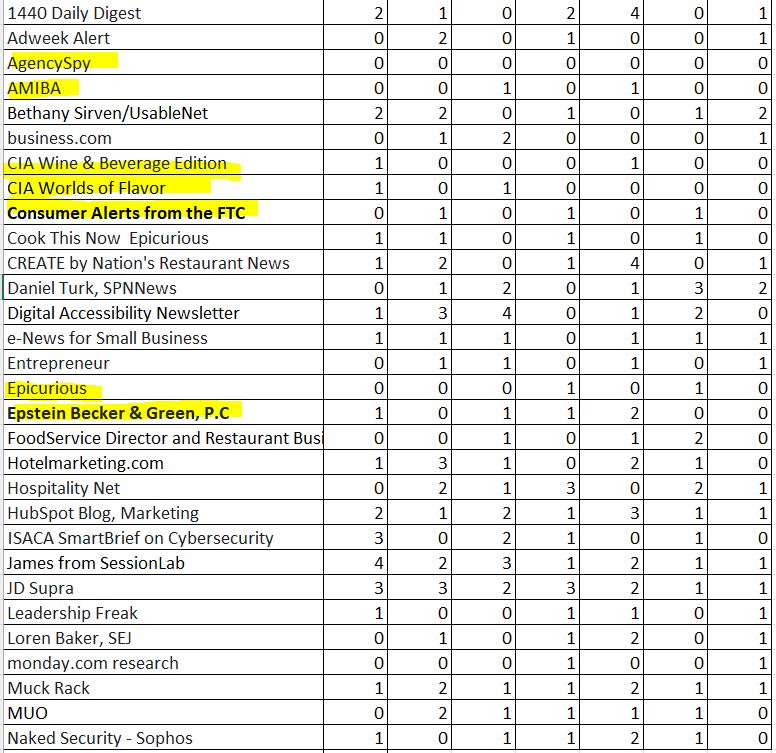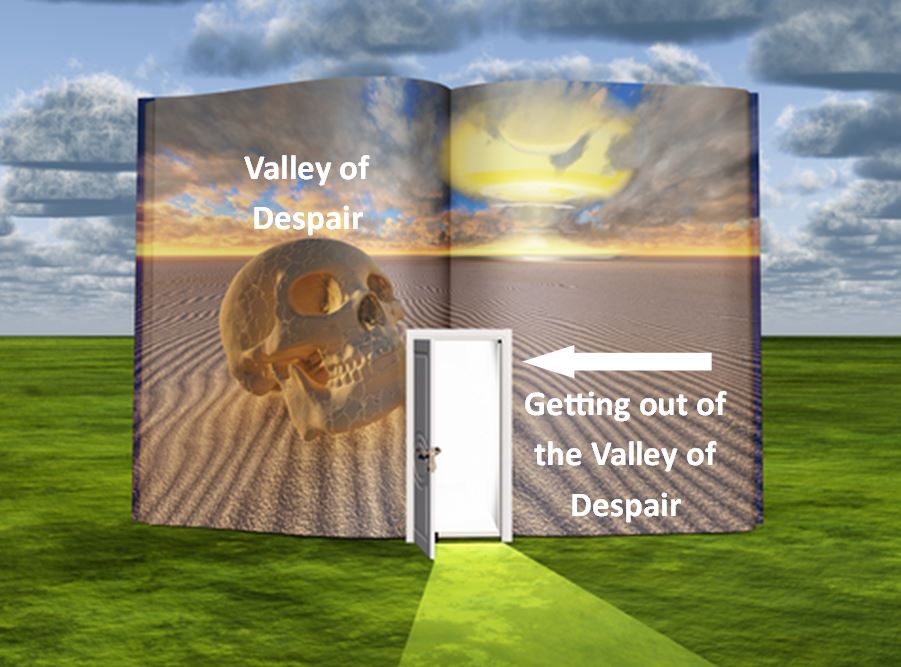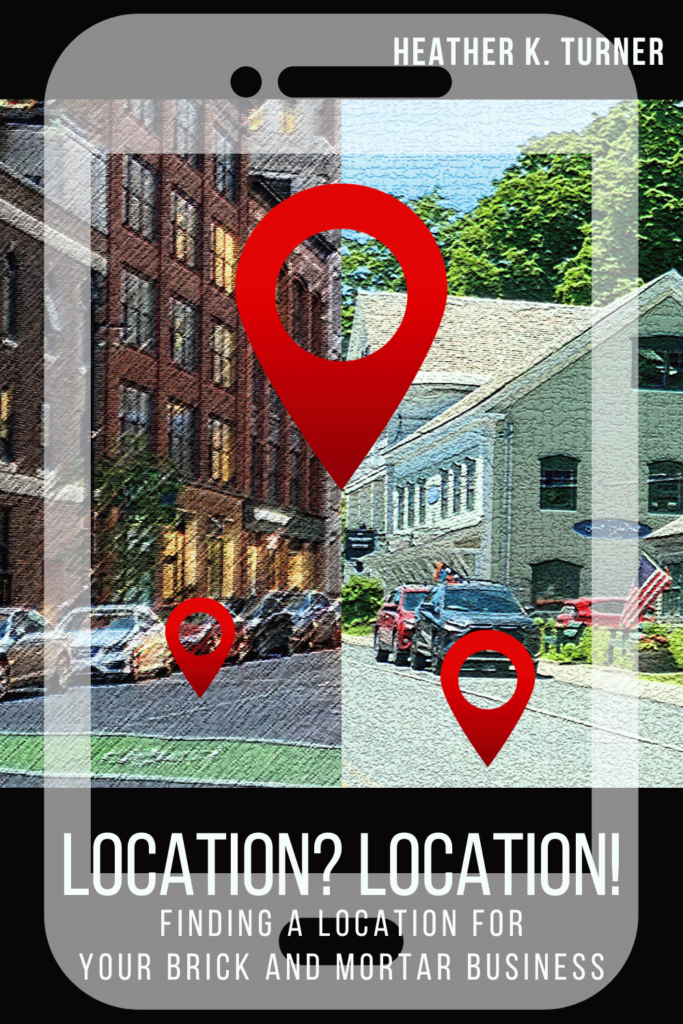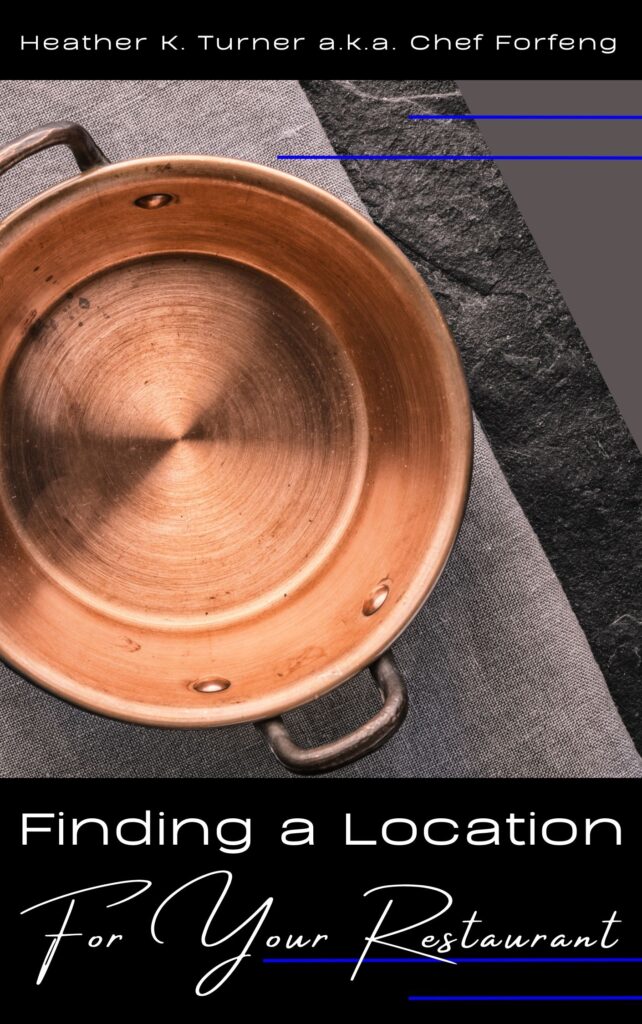by Heather T. | Jun 21, 2022 | Email, Email Marketing, Operations, Opinion
 Many business owners are overwhelmed by email, some more than others.
Many business owners are overwhelmed by email, some more than others.
Many are just overloaded by industry information, newsletters, and other material they want to keep up on or are interested in.
Email boxes can also get clogged by special offers and specials from companies a business owner might buy from, both professionally and personally.
I want to share my method for keeping my email box in check. It’s not a quick fix, but it’s well worth it if you get a ton of email that is not directly related to customers or clients. It is easy, though, you just have to stick with it for a little bit.
This method can be used for any type of email, whether it’s local news, special offers from Lowe’s, or anything else you want to apply it to.
I call it the rule of three. It means that whether it’s a daily email, a weekly, or monthly email, you want to get at least three interesting articles of learning, a special offer you will actually use or take advantage of, or important news from a newsletter throughout its distribution period.
So a daily email needs to have at least three relevant outgoing links over the course of a week. Or three links per three weeks or three months if that is the time distribution.
People statistically sign up for a newsletter more often than they might think. They may go shopping somewhere, either online or off, and get added (or add themselves) to a newsletter.
While some people just cruise through and delete non-relevant emails, it still takes a few minutes, even more time if you spend the time opening them. That small time period starts to add up over the course of a week, a month, a year……

Periodically I make a list of all the emails I get on a weekly and monthly basis, and I keep track of them. I open up Excel and save the file, but keep it open on my desktop so when I do my morning review of non-client emails before I get into regular work mode, I can log them.
I don’t count the links I clicked because the title was catchy and caused me to click into it, I log the articles and links I found useful.
An excel spreadsheet or Google sheets work very well for this, or if you prefer old school, put your titles in a blank sheet and make hash marks on it.
There will always be some very important newsletters, and I bold those because regardless of the frequency of good articles, you may need them for business, or they are very important to read even if it’s not every single email. As you can see from this example, there are several emails I subscribed to a few months ago because I thought they sounded interesting that need to go.
You can also bold/highlight or colorize an individual numerical group. There is no wrong way to go about this, but actually reviewing your incoming email can really help with time management as well as your own sanity in getting overwhelmed (or not) with emails.
I’ve used this system for years to manage my inbox and have found it works well.
by Heather T. | Jun 14, 2022 | Business, Opinion
 One of the most challenging issues I find business owners face, especially in regards to themselves as owners is perfectionism.
One of the most challenging issues I find business owners face, especially in regards to themselves as owners is perfectionism.
It’s your business, your baby; you live, eat and breathe it, and so you tend to get overly hard on yourself.
If you notice that you are being self-critical of yourself– and spinning in an endless cycle of blaming yourself – it’s time to take a step back and think about how you can coach yourself out of that downward spin.
Before I move on to the three things that can help you get out of that deadly spiral of defeatism.
I want to give a couple of quick examples of being self-critical.
Telling yourself, “Oh Man, I REALLY blew that interaction with a client; what is WRONG with me!” and “I can’t believe I missed that deadline to get that ad into the paper. I NEVER miss deadlines.”
There is a very fine line between healthy striving for perfection and self-defeating perfectionism. From the perspective of your employees (if you have them), it’s even harder to cope with someone who has to have everything perfect, and even harder to deal with when their boss gets stressed about perfection, whether it’s their own or someone else’s.
For people who aim for the sky, failure of any sort can be a tremendous blow and can lead to depression and other negative mental thoughts, which can be self-harming.
You can identify to yourself when you are being overly self-critical when you find yourself doing the following three things:
- One. Needing to be in control and being obsessive about it, and needing to micromanage projects.
- Two: Having a fear unto obsessiveness of making a mistake, ANY kind of mistake.
- Third but certainly not least: Constantly asking for reassurance from others, “Do you think we will get the numbers?”, ‘Do you think this will bring in sales?“. And owners do ask those questions of people they work with and employees. If you are a sole proprietor, that is even more of a burden to bear because you generally don’t have anyone qualified to ask for that reassurance.
When you find yourself doing these things, and you may need to consciously think about identifying when you do these, you need to take a step back, and again you need to reassess.
You are doing more damage than good to yourself.
Inside every person striving for perfection is the lizard brain, which is the little voice inside you screaming: “Everything is on fire, Only I, PERFECTION MAN (or WOMAN)! can put out the flames!”
You need to learn how to rein in and control that lizard brain.
Here are some steps that I have found to help tame that obnoxious little beastie.
Step One is Self Compassion and learning to be more self-confident.
Take a hard look at your past successes and cut yourself some slack.
No one reaches the finish line 100% of the time; this is an unrealistic goal. It really IS!
That doesn’t mean setting a lower bar for yourself. It just means you need to be more confident that when you DO fail at something, you can tell that pesky little internal lizard brain that you did the best you could with the tools you had at the time.
I’ll give you a broad example of this: I’ve seen so many perfectionists beat themselves up because a project has failed, but it was because the success was reliant on someone ELSE who dropped the ball
OR
The person was not provided the tools or skills they needed to accomplish success.
The perfectionists still beat themselves up as if it were their fault.
As a side note, Self-confidence is also something you can learn from being a part of Toastmasters.
People are not born self-confident; it’s a learned skill, just like being a leader.
Step Two is understanding your crutches.
It’s not enough to tell yourself, “I NEED TO STOP BEING SO HARD ON MYSELF.
Those are just words. Empty words.
Take a step back and ask yourself, and I’d really like you to think about this: What story or stories are you telling yourself that is getting in the way of your progress?
What stories are you using as a crutch to beat yourself up?
Is it that memory of a parent or boss who was a great parent or boss but ONE time they slipped because you had stretched their patience to its absolute maximum or they were having a really, really bad day and being human, said something they regretted and that ONE thing stuck in your memory and became self-defeating?
That story or stories you subconsciously tell yourself are roadblocks, and until you can understand them within yourself, they will always be roadblocks.
Step Three is to embrace your inner critic; that darn pesky lizard brain has two additional distinct faces aside from the one trying to play Fireman Dan all the time and obsessively putting out fires.
The two additional faces are the analyst and the advocate.
The analyst face looks for the unhelpful statements that you keep repeating to yourself, to use my earlier example, “Oh Man, I REALLY blew that interaction with a client; what is WRONG with me!, and then adjusts them, so instead of “Oh Man I REALLY blew that interaction with a client, What is WRONG with me!” adjust it to be “Yes I DID screw up that interaction and made a mistake, but I’m going to help fix it and see if I can get the client back and this is what I am going to do………”
What is your positive spin and goal going forward? Make that the self-edit/self-adjustment.
The advocate is the self-compassionate face, the one that says, “I’ve gotten through similar obstacles in the past,” I know I can do it; if I don’t make it this time, I won’t stop trying.”
Look at your advocate and give your advocate advice as if you were giving it to a good friend who has self-doubt. Look at yourself in the mirror and talk to it as if your reflection was that friend. What would you say to them?
You might notice all three steps revolve around having compassion for yourself.
Encouraging yourself to have self-compassion isn’t letting yourself off the hook for mistakes and missed goals.
It’s about encouraging a healthy mindset to rebound from setbacks so you can build resilience and move on to a more productive work and personal life.
There is a great book by Spencer Johnson called Who Moved My Cheese that was required reading at the Culinary (and many other colleges, apparently) and describes how one reacts to major changes in one’s work and life.
To appropriate that theme a little bit. I encourage all of you that lets the lizard brain take over, feed him, or her, some cheese; they love cheese.
String cheese and self-compassion cheese are the best. As an added bonus, dairy helps put out hot flavors, essentially quenching the lizard brain’s constant need to put out the fire.
by Heather T. | May 19, 2022 | Business, Opinion

The Valley of Despair, seems so ominous, doesn’t it?
Well it is, actually. But it’s a step, and it leads up, or it leads down permanently, depending on how you approach things.
It’s a term I have found usually used in project management and change management, also called the Emotional Cycle of Change, a model developed by psychologists Don Kelly and Darrell Connor, the curve has been modified a bit by many, including myself. If you Google the cycle you will come up with a variety of graphs, my personal favorite is from evocon, which I think sums it up perfectly (scroll down about half way down the page). Somewhat similar to Kübler Ross’ Change Curve, which talks about the five stages of grief, where the curve starts high, drops into a valley and then rebounds. I find the cycle particulary applicable to people trying to start a new business.
If you Google “Valley of Despair”, you will also come across the Dunning-Kruger Effect, which explores the cognitive bias people have on assessing their own ability. This is no relation other than using the same terminology.
Before I touch on the five stages of the cycle, I have found that there are three types of people who want to start businesses, and while it’s a little bit of a generalization, I find it’s pretty accurate.
1. The ones who have a dream (to start a business) and have motivation.
2. The ones who have a dream (to start a business) and have done their homework first.
3. The ones who would like to be their own bosses or whatever they feel is the reasoning behind thinking they want to own a business and have an idea, but no real motivation (other than the dream) and have not done any homework.
#1 & #2 are the people who usually start businesses and do well. #3 rarely makes it out of the Valley of Despair and almost always quits at the low point. But that can be changed with the right attitude, and researching and reassessing.
The five stages of the cycle:
The first stage is Uninformed Optimism: otherwise known as hope and excitement “I’m going to be my own boss!!”
The second stage is Informed Pessimism: otherwise known as reality starts to kick in. “Oh My Heavens, there is so much to do! So much to learn! Arrgggghhhh!!!!”
The third stage is The Valley of Despair: otherwise known as “abandon all hope who enters the cave of doom”, cue evil laugh from the shoulder devil who doesn’t want you to succeed and whispers in your year, “You can’t do it.” This is where a lot of entrepreneurs give up. It’s too hard, it’s taking too long, it costs too much.
The fourth stage is Informed Optimism: where people who have clawed their way out of the pit put into practice all the things they learned they had to do to start their business.
The fifth stage is Success: where people start their business, open their bakeries, auto repair shops, or coaching businesses, whatever their dreams and aspirations are.
I’ve found working with startup businesses that these are some of the best ways to get out of the Valley of Despair.
Reach out for help. There are so many free resources out there for startup businesses. SCORE, for one. My suggestion (as a SCORE mentor) is when you are requesting help, tell the Chapter (there are Chapters all over the United States) a bit about what you are looking for and what kind of help you need. It helps the Chapter better match you with someone who can assist you. If you are matched with a mentor who you don’t click with or does not have the skill set you need, you can ask them to pull in a co-mentor or co-mentors with those skill sets and expertise. Or you can request someone else. This is a person you will be sharing personal and business information with, and there is a big trust and relationship aspect to it, so it needs to be the right fit.
I would be remiss in not mentioning a few of the other resources out there. There are also state-level programs, so use Google. It’s your best friend when it comes to starting a company.
Small Business Administration (SBA)
SBA’s Ascent: Explore Ascent (for women entrepreneurs)
SBA’s Boots to Business (Active Duty Service members (including National Guard and Reserve), Veterans of all eras, and spouses are eligible to participate.)
Small Business Development Centers (SBDC)
IRS Small Business and Self-Employed Tax Center
I would check out SCORE’s list of startup resources as well which has a laundry list of sites to check out.
Don’t forget to check out your local Chambers of Commerce and other local services. Many states and regions have specific programs for startups as well.
Take a step back and reassess. Is this the right business? Is this the right direction? Is this the right time? Is this the right market? If you haven’t done your research yet, do it NOW before going any further and causing yourself more angst. And in many cases, before spending any more money.
Some additional questions to ask yourself:
Is this financially viable at this time?
If you have a family or signifigant others in your life, are they on board with this? If not, why not? And if they are not, is this going to cause issues down the road?
What are your setbacks? Are these really unsurmountable setbacks? Or are you getting frustrated because you are not getting past those? If the frustration level is high, put that setback(s) aside for a while and focus on something else. Revisit when your mind is clearer and calmer.
I’ve also found that helping others at their low point can help you get out of your own. The value of networking with other small businesses and startup business owners allows you to have a sounding board for yourself, and looking at other’s setbacks and issues from an exterior perspective often gives you insight into how to tackle your own.
Just quitting without at least trying to do these steps and reaching out for help leaves internal resentment and regret that you had a dream but didn’t make it happen. Doing the steps above helps give you some closure and enables you to realize that you can start a new dream or revisit this one at another time, or that you can go forward and succeed.
If you have a dream of becoming an entrepreneur, go for it! The best advice I can give you, though, is to do your homework first!
by Heather T. | Jan 13, 2022 | Marketing, Operations
 I recently had a friend ask me how to do competition research best online. I’ve also done several workshops on this prior.
I recently had a friend ask me how to do competition research best online. I’ve also done several workshops on this prior.
Competition research or comp research is very easy to do; it’s just time-consuming and if you want to do it right (suggested!), do the time; it will be well worth it.
Step one and you can do this is a spreadsheet, or you can do it in MSWord or Google Docs. I like using a combination of both, a spreadsheet in Google Sheets for the base information and then linking it to a Google Doc with more information. I also like to take screenshots, LOTs of screenshots. Screenshots of their website, screenshots of their social media posts, as well as screenshots of reviews, both good and bad.
Some specific things I look for are an email newsletter (if so, sign up!) Do they post consistently on social media, and are they getting engagement from what they are doing (or not) if certain posts or post types are getting high engagement, screenshot them!
While on a PC you can take a full screenshot using “PrtScn” on your keyboard, I prefer the snipping tool that comes standard. It is in the Start Menu under Windows Accessories. It lets you be selective about what you snip and allows you to mark the image up.
For Mac users, instructions here on screenshots https://support.apple.com/en-us/HT201361
A few of the other things I look for are their reviews. Do they respond to reviews, just the bad or the good and the bad, or not at all? How are the review responses? Are they well crafted and polite and try to address the problem, or are they defensive and combative?
You can learn a lot from reading competitors’ reviews, both from their excellent reviews (these are key things your business will have to concentrate on competing with) and the bad (these are things your business can excel at and blow away the competitors). Check all the review sites, Google My Business, Facebook, Yelp, BBB, etc.
Have they optimized their directory listings and their social media accounts? Do their links work? Do their links to social media channels from their website work? I’m always surprised by how many businesses don’t pay attention to this; they change their social media handle but forget to update the links on their websites.
In reviewing competitors, social media listings look at who they follow (its public to view) and who follows them. Keep an eye out for an overabundance of fake follower accounts. They are easy to spot once you start to eyeball them. You can also quickly tell if someone has a high follower/like count but zero engagement on posts. Please don’t buy followers. Yes, it is cheap to do, but it does nothing for you except inflating your following and dinging your credibility. And there is no value as a business owner for doing so.
While there are a lot of paid sites out there where you can do backlink research, my personal favorite https://www.semrush.com/ (not an affiliate link), I like the program; they generally have a free trial period that I encourage businesses with limited budgets to take advantage of. For anyone who needs to do high-level ongoing research, the pricing at $120 a month can be worth it.
You can do all of this research using a tool, but I also like doing it organically because when you search for the business in Google and Bing (and do both because you will get differing returns), you also see the snippets from the sites that are linking to your competition. It can help if you see a competitor is linked from a site that’s relevant and it’s a junk link connection, rather than one of the research tools which gives you the link.
The easiest way to do this is to go to Google and Bing and put in variations. Put the information in quotes for the best return: “Business Name” ie. “Jane Doe Inn.” If it has an LLC or other variations, Google those too. “Phone number,” ie “860-555-1212” and then their domain name. Don’t add the http/https or the www (if they include it), just the domain and the extension ending, i.e., “janedoeinn.com.”
This is a base of what I use, and then I add additional things like pricing, like services, what they offer etc.
Business Name:
Name:
Physical and Mailing Address(es):
Phone Number(s):
Email Address(s):
Domain Name: ( ie. https://www.janedoeinn.com)
Notes:
ADA Score: (I use Lighthouse for this. https://developers.google.com/web/tools/lighthouse)
Notes:
SEO Score: (I use Lighthouse for this as well)
Notes:
Mobile Friendly: (Is their website? Some sites look great on a computer, not so much on a cell phone or tablet)
GMB: (this is Google My Business, add the full URL))
Reviews: (how many reviews, review rating, do they respond? Don’t forget those screenshots)
Notes:
GA Analytics: Yes/No
(this is Google Analytics, you can see if they are using it and the next note as well about Plugins by putting their domain name/url into https://builtwith.com/ . This is also useful because it will tell you what the site was built with.
Plugins if WP: (WP is WordPress, you may see some things you like on a WordPress site, like a photo slider or gallery and you can find out what plugin was used)
Blog: (add the full URL)
Followers (IA): (IA is If Available, some blogs have that public)
Notes:
Average blog post word count:
Newsletter: (what are they using? Constant Contact? Mailchimp? Other?)
Notes:
Privacy Policy: (I add yes or no but if yes add the link, same with the ADA policy)
ADA Policy: (This refers to ADA Website Compliance, add the full URL)
Covid Statement: (If yes add the full URL)
Facebook: (add the full URL, ie https://www.facebook.com/janedoeinn)
Likes:
Followers:
Notes:
What Kind of Content are they posting?
Facebook Ads: (You can see if a page is running or has run Facebook ads, not boosts, just ads, by scrolling down on the left hand side of a business page to “Page Transparency”. When you click on that, you can go to “Ad Library”.
Reviews: (number and comments)
Notes:
If you really want to dive deep, track down the owner’s and manager’s personal profiles, I realize this seems rather stalkerish. From a business research standpoint, most people don’t have their profiles totally locked down. You can gain some very valuable business information about what groups they belong to, as well as whether they are sharing their business posts onto their personal profiles.
Instagram: (add the full URL)
Followers:
Following:
Notes:
What Kind of Content are they posting?
Twitter: (add the full URL)
Followers:
Following:
Notes:
What Kind of Content are they posting?
Youtube: (add the full URL)
Followers:
Notes:
What Kind of Content are they posting?
Pinterest: (add the full URL)
Followers:
Following:
Notes:
Linkedin Page: (add the full URL)
Followers:
Follower
Notes:
What Kind of Content are they posting?
If the primary owners or managers have personal Linkedin accounts, I also like to take a look at them. If you don’t want accounts to know you have viewed their profile, you can go into your own personal Linkedin settings and change how you appear. Go to “Me” then “settings and privacy”. Then “Visibility” on the left side and “Visibility of your profile & network”. Next in the middle, go to “Profile viewing options”. If you select “private mode”, I recommend that you log out of Linkedin and then log back in and check. I’ve heard reports that sometimes it doesn’t take, and it is better to log back in and check to make sure before assuming.
Other Ads/Google PPC: (if you use a tool like Semrush and many others, they will tell you if comps are running ads)
Notes:
Yelp: (add the full URL)
Reviews: (number and comments)
BBB: (add the full URL)
Reviews: (number and comments)
Bing: (add the full URL)
Indeed: (add the full URL)
Employee Reviews: (number and comments)
Glassdoor: (add the full URL)
Employee Reviews: (number and comments)
Checking Employer review sites give you an excellent insight into the competition.
Sites of Interest/Linked from:
Review your comp lists every three months or optimally every month or the very most every six months. Competitors change pricing, change offerings, change services, bring on new key staff or have them leave.
If you are not looking at your competition, you can guarantee some of them are looking at you. And if you are not keeping an eye on their pricing changes or new offerings, you can lose business because you are not staying on top of it. The time spent on reviewing gathered information is well worth it.
by Heather T. | Nov 30, 2021 | Blog, Opinion
 I recently did a Toastmasters two-part speech project and thought it would make a good blog post. The project was to give a speech and then give the speech again based on the first speech’s evaluation.
I recently did a Toastmasters two-part speech project and thought it would make a good blog post. The project was to give a speech and then give the speech again based on the first speech’s evaluation.
I ended up giving this short speech to three different Toastmasters clubs, one club is the club I am coaching, and the feedback I got from all of them was pretty interesting.
In all three meetings, heads nodded, and the comments afterward were, “Yes, we have ourselves done all of these things, both personally, in business and leadership situations.” I know I have as well in the past and have tried my best to cut them out.
Dan Rockwell has been one of my favorite blog writers for years and most definitely one of my most favorite leadership article writers. His posts don’t always have the answers and the solutions to things, but they make you THINK!
From a leadership perspective, that is invaluable because there are no perfect solutions to leadership issues.
Every situation is unique, and what works for one doesn’t necessarily work for another.
Gaining some insights about how people react and stimulating your brain into thinking about scenarios that may happen or have already happened gives you an awful lot of insight into yourself and how you deal or would deal with things that may come up.
He recently wrote a blog post, 12 Things Smart Leaders Don’t Say, and it really got the wheels turning a bit more than usual.
His blog has 12 questions, but I cut it down to six (technically seven because I combined two) for two reasons, my first speech when I based it on my additional commentary to his questions was too long (almost 12 minutes instead of the target 5-7), and when I started to rewrite it, I found that these questions resonated with me more than the others, mostly because they made me “think” about them more myself.
Question #1.
Dan writes: Don’t say, “You should have. Why didn’t you? and “I should have”
He comments: ‘Should have’ is backward facing. Do your best to speak into the future.
Instead of shoulding-yourself, say, “Next time.”
I’m adding to this, “YOU should have” is very negative, it’s a blame game, and something parents do to guilt their kids and makes people feel small and insignificant. “Next time” is a great starter, but adding, “Let’s try this next time” is even more encouraging.
In leadership, it’s also worth considering that maybe the “you should have” is really on you for not providing enough information or direction to the person that “should” have done something. Is it that person’s “fault” something went sideways, or was it your own?
From a leadership perspective, I think of all of the questions, this should be the biggest takeaway for people in management. Is it “really” an employee’s fault or ?
Question #2. (Dan’s #3)
Dan writes: Don’t say: What can we do about that?
He comments: ‘We’ is a tiny act of cowardice that softens the blow of responsibility.
“What could ‘you’ do next,” is better than, “What could ‘we’ do next?” (Unless you are planning to actively participate.)
It’s insincere to say ‘we’ when you really mean ‘you’.
I’m adding to this, Toastmasters tries to teach us to say “we” because it’s inclusive and that’s what leaders are supposed to say, but too often leaders, both in organizations and in business, say “we” but leave the actions and the follow-up to others, most often the ones that need the help most.
Leaving someone hanging is passing the buck, and it’s saying it’s not that leader’s problem. If you are truly going to say “we,” MEAN it and participate. Please don’t put it on someone else.
If you say “you,” then follow up and give the person or the group some tools and directions to fix the problem or issue and the ability and assistance to solve it, don’t just leave them hanging in the wind.
Question #3. (Dan’s #4 & #5)
Dan writes: Don’t say: It’s simple AND It’s easy.
He comments: What’s simple to you is often difficult for others. Judge people through the lens of their experience and strength, not yours.
I run into this all the time. In Toastmasters, Pathways is a good example. I think it’s easy, I’ve also been using it since it literally first rolled out, and I’m in the interface several times per week. For many others, it’s not easy, and when you don’t use something all the time, it’s not “simple.”
I hear marketing people say this all the time about using social media, and it drives me bonkers. “It’s so simple, and it’s SOOOOO easy to do.”
Well that’s because they swim in it all day long, for business people who actually have other things to do, like run their businesses, it’s not easy, it’s not intuitive, there are no big red buttons and guides that say do this, do that to proceed to the next step.
It’s also a belittling comment because it makes people think they are not smart enough for not “getting” something that is according to someone else “easy” or “simple.”
When I do SCORE mentoring, I also run into this quite a bit with clients who are frustrated that they don’t “get” social media, website development, or SEO and have been told by someone else that it should be easy.
Why should they get it? It’s not their fields, yet some marketers out there make people feel small by saying things like, “oh, that’s easy, you shouldn’t have any problem with it.”
I don’t know how many times I’ve caught myself starting to say that and then booted myself into a reality check. And I freely admit, I used to be guilty of saying this to people myself and had a massive wakeup call a couple of years ago.
Question #4. Dan’s #8
Dan writes: Don’t say: Don’t you agree?
He comments: Questions that begin with ‘don’t’ insult people’s intelligence and pressure them to agree. Who’s going to say, “No,” when you ask, “Don’t you agree?”
Don’t you agree is also pressure on people to “make” them agree, so they feel like they are a part of the group, it goes back to the comment “You should have” it’s not just insulting to people and pressuring them, it’s also giving a guilt trip (funny how guilt trips come up twice in things we shouldn’t be saying, and how learned mannerisms as well as phrases creep into our speech as adults). A good alternative is “what do you think? I value your opinion and your experience or expertise.”
Don’t you agree it is a lot like “With all due respect”….. Every time I hear someone say that I cringe, because I have rarely heard anyone say that and then not completely tear apart or disregard the other person’s opinion. I’d add that to the list of things that Leaders should probably stay away from saying.
Question #5. Dan’s #10
Dan writes: Don’t say: But
He comments: Never say ‘but’ after saying something good. Try using ‘and’ when you’re tempted to use ‘but’.
‘But’ is an eraser.
But is not only an eraser but also a contradictor, You did a great job with your speech, and I really like the examples BUT>>>>>>>>>>>> Terrific job with that presentation and you really impressed the client BUT>>>>>>>>>>>>
In Toastmasters But is a filler word, as is And, but the grammarian and ah counter are more likely to flag you on But as a filler word because it doesn’t lead into anything else, it contradicts and it fills space where it doesn’t have to.
I agree that AND is a good substitute. Think of it in the context of doing an evaluation, or giving feedback to an employee, “Here are some great things about your speech AND here is a little bit of room for improvement. Fantastic job with that report, I particularly appreciated you including next year’s financials AND maybe next time can we add an additional 6 months worth?
Question #6. Dan’s #12
Dan writes: Don’t say: Nice job.
He comments: Be specific, not vague, when giving compliments. What was ‘nice’ about it?
That was a really “nice” speech, Eh? What does that mean? Was it sugar and spice and everything nice? Was it nicely wrapped in a box with a pretty bow? It was nice, because………………… ?
I used to work with a fellow chef at a resort with multiple restaurants that was always saying to his staff, “Nice Job, Nice Job.” His employees used to mock him for it because he would never give specifics, and it came across as insincere. He thought from a leadership perspective it sounded good to say that to staff, and it became like an automatic reflex, but his employees hated it.
Give some specifics, “Nice job with that catering order today, the clients were really happy with everything, and the bride especially liked the vegetable canapes.”
What we say as leaders defines us, and we can either help lift people up or drag people down, and being cognizant of what we say and how we say it makes us a good leader or someone who has some work to do.
Sometimes little things like wording both verbally and written can make a huge difference especially when giving feedback to someone.
Original post here and CC License for Mr. Rockwell’s post attribution.
by Heather T. | Nov 9, 2021 | Blog, Marketing, Operations, Social Media
 This is an updated post on one I had done way back in 2010 (yikes it’s hard to believe that it’s been over decade, but still relevent) with bit more information and a couple of additional ideas.
This is an updated post on one I had done way back in 2010 (yikes it’s hard to believe that it’s been over decade, but still relevent) with bit more information and a couple of additional ideas.
I thought it might be time to update it, as it’s one of the most common questions I get from people, even when I tell them you know………. there are a ton of ideas and post ideas out there already floating around and don’t forget to look at what your competitions doing,
Sometimes people want some more specific ideas, so I thought it was time to give the post a little spiff up. I do find it kind of amusing that the old post refered to “fan pages”, Facebook’s original name for a business page.
(Keep in mind many of these could be in visual or image formats including video) Many can also be used for blog posts with some additional information and content. Visual/Image posts are best for Instagram. Linkedin business and personal pages, Facebook business pages and groups, and Twitter, it is best practice to try to share an image with text.
*Don’t forget to share links to your website often as well.
The number one mistake in using social media is forgetting to add targeted links to posts. People will not look for your website link if they don’t see it in the post itself.
If you have a product or service, you are promoting on social media make your links count. If you are talking about a particular service you offer, have the post link go to your services page where you talk more about the service, NOT to your homepage, you don’t want to make people have to hunt.
- A promotion.
a. Come and stay during the month of March and get two free ski tickets.
b. St. Patrick’s Day Special, get a complimentary green beer & popcorn with an order of bangers & mash (*must be 21) = 117 characters, still room for using a shortened link on Twitter.
c. Get double points on your Ace rewards card with every hardware purchase the first week of March.
d. With a purchase of any Don Fredo jewelry, get a free earring cleaning kit.
e. Get a full hair coloring treatment and receive a free trim.
f. At your next tire alignment, get a free oil change.
g. New accounting customers get a 10-minute free business analysis.
- A sale.
a. Thursday nights are half-price appetizers.
b. Sale though March 31 on Dunlop All-Season Radial Tires, save 20% off.
c. All Michelle Leslie tops and slacks on sale $15 off through this Sunday.
d. Stay 2 nights get the 3rd night 1/2 Off.
e. Two for one wool sock special every Saturday.
f. Mini-mart Super Gulps 99¢, 5-6 pm every Monday – Friday.
g. Photography special: Book a wedding with us and get an extra set of CD’s with your photos now through May 3.
- New products, services, specials, rebates, vouchers, offers, packages
- Recipes (recipes get one of the highest rates of pass-alongs in social media, if you are a retailer, share your Grandma’s killer brownie recipe and make it the next time you have a sale at your woodworking store. It doesn’t matter what business you are in. Also, Recipe failures with a funny story make great shared content.
- Guest, customer, or client comments or testimonials (with permission if sharing the full name).
- Your business in the news.
- Your business is getting or received an award.
- One of your employees is getting/or gotten an award, even if it’s of your creation, i.e., best salesperson of the month.
- Your area in the news.
- Promote any upcoming events. Open Houses, classes, workshops, webinars, networking, etc.
- A frequent and loyal guest, customer, or client in the news, please be aware of privacy though, depending on your business, a client may not feel comfortable with you sharing the information unless you know them well, it’s best practices to ask if it’s ok.
- Pictures of your business, interiors, exteriors, products (if applicable).
- Pictures of your employees.
- Pictures of happy guests, customers, or clients (with their permission and preferably in writing or verbally but documented).
- Area Events going on, you can also tie this into specials and promotions you are holding.
- A brief, “we get frequent questions “about” and put in answers.
- What does your business do to differentiate itself from others.
- Holiday Posts, a nice graphic or photo and a wish for a Happy Thanksgiving or other Holiday.
- You just found a new product you are using and love it, be it food or a new fabric softener or a new electric cordless drill; describe it and explain why you love it.
- Day of the Year posts. National Calendar days. May 20 is National Rescue Dog Day. It’s helpful if it ties into something related to your business. Two of your own dogs are rescues. One of your employees volunteers at the local dog shelter.
- Funny Loyal Guest, customer, or client stories. *caveat: make them funny and only funny, proof heavily to make sure they are not harmful or negative in any way. While someone may go into the wrong changing room by mistake at a store, and it may have had very amusing consequences, it raises things like, “don’t they have locks on the doors?” (even if you do and point out they didn’t lock them).
- Do some product/area/service-specific reviews. You have a couple of apple orchards nearby. Do some write-ups on the apples, do some research on types of apples, link to sources. You carry a particular line of clothing or cordless drills or snow tires; what is special/different/better/unique about them.
- A bio of your self or other owners or management.
- Bios of your staff.
- Interview customers. Keep in mind using video is always a bonus.
- Interview vendors.
- Helpful Tips: examples: restaurants; a good wine, lodging; cooking/baking tips, realtors: home buying tips, Landscapers: gardening tips, mechanics: car care tips, drycleaners: stain removal tips. For every type of business, there is always helpful information out there that someone can use.
- Industry News.
- Ask for feedback from blog readers, fans, followers, and from prior guests, customers, or clients. You just went from goose down pillows to memory foam pillows. If asking on a blog post, ask for some thoughts from people, and don’t forget to include the link to the blog article or post link when you do your next email blast. You just switched from using Redken products to Matrix Biolage in your salon. People love to be able to give feedback and asked what they think about things; this is an excellent medium for doing that, exploit it. Questions asked are great prompts, and you can get valuable information on your own business or something new you may be considering doing.
- Help wanted posts.
- Lists. List posts get high engagement. 10 of our top selling products. 12 of our favorite woodworking bloggers, 15 tips on saving money, 7 best places to go to get Sushi, etc.
- Links to resources, also great in list post format. 10 places to save money on your business insurance.
- If you are blogging, don’t forget to share your blog posts on your Facebook business page, your personal Facebook account, Facebook groups (if it’s permitted), Twitter and Linkedin personal and business pages. If blog posts have images (highly recommended), don’t forget to pin the image (with your blog post link) to Pinterest if you use it.
- Videos from Youtube, Vimeo and Tiktok.
- PSAs, especially ones that are relevant to what’s going on in the world today. Try to stay away from politics or religion.
- A Non-profit or charity you support.
- Your business contributing to the community or donating a product or service.
- A giveaway, contest or drawing. Please make sure you check each social media’s T.O.S (Terms of Service) before promoting these online, each has different requirements and disclosures.
A few ideas for Business Social Media Platform Shares
(Facebook (Personal, Business & Groups), Twitter, Pinterest, and Linkedin (Personal and Business)
While Instagram does have external apps to share posts, PLEASE ask permission first of the Instagram author. On Youtube, you can add videos to “Playlists”
https://support.google.com/youtube/answer/57792?hl=en&co=GENIE.Platform%3DDesktop
and
https://support.google.com/youtube/answer/57792?hl=en&co=GENIE.Platform%3DAndroid
If sharing on Facebook from a personal account, please ask permission first.
- A gorgeous photo taken of your town, your area, your state (make sure the author gets image credit, shares from a page, or their own group rather than uploading a photo are highly recommended so you don’t violate copyright.)
- A vendor or a company you buy from shares something of interest related to your product or business.
- Funny or amusing content, try to keep it clean.
- Helpful tips (not the same thing as Educational content as these are generally short form posts) from non-competitors.
- Educational content. A blog post from a Leadership expert with a little of your personal feelings about why you liked it or something that stood out about it.
by Heather T. | Oct 28, 2021 | Blog, Opinion
 This week and next, I have the great pleasure of working on a Toastmasters Speechcraft program with a fellow Toastmaster and CIA Instructor. We are working with ten culinary students from all three CIA campuses on the CIA’s Diversity Council Speechcraft program.
This week and next, I have the great pleasure of working on a Toastmasters Speechcraft program with a fellow Toastmaster and CIA Instructor. We are working with ten culinary students from all three CIA campuses on the CIA’s Diversity Council Speechcraft program.
My fellow Toastmaster shares, “The participants are students completing their Bachelor’s in different food-related fields at the Culinary. They are leaders of the Black Culinarian Society, the Latinx/Hispanic Club-Hermanos Sin Fronteras, and the Student Government Association. These students are very focused on their studies and are career-oriented individuals who are committed to creating a more just society. Some of them were or are currently my students. Their passion for their profession is inspiring!”
My fellow Toastmaster and I spent an additional half an hour on Zoom last night after the meeting catching up on the school and on past Instructors. Corky Clark and fish kitchen, as the group leader, Chef Clark made my life living hell in that class and then was one of my go-to guys if we ever needed anything. Chef Papini, one of my favorite chefs at the CIA, “You have to sing to your food, it’s like a butterfly, you have to treat it with love” he used to quote in class, plus a few stories of him throwing a temper tantrum at us for various things, including doing tourned potatoes wrong. To this day, I find those memories hysterically funny. I recall being petrified at the time, though. Stories from decades ago.
A story I didn’t get to share, but will in a future session, is the small kitchen in one of the dorms we could use to cook in (if you dared) that if you looked up, had hundreds, nay thousands of strands of dried spaghetti hanging from the ceiling. One of our Table Topics questions for the students on Monday was, “Have you ever thrown spaghetti against the wall to test for doneness? — If it sticks, it’s done (so they say) — If not what other such kitchen habits might you have?” I think I will have to tell the students about the kitchen because I’m sure they will get a kick.
What has impressed me most about this younger generation is the willingness to step up, not necessarily to be bold, but to be there in the first place, to look for something that can help improve themselves even more and improve their leadership skills.
In ending last night’s session, we discussed what we would be doing for the next session on Monday, which is to practice evaluations, ie, giving constructive, not critical, but constructive feedback on other people’s speeches. I mentioned and repeated it that I truly wished I had joined Toastmasters when I was a Chef because Toastmasters has taught me the value of being constructive rather than just critical and also ways to suggest improvement in whatever someone was doing. How valuable a skill set is that!
Instead of just screaming at a line cook and telling them what they did wrong, in hindsight, there are much better ways. When my fellow Toastmaster brought up how I made such a point of this at the end, I passed along that I was a screamer, a plate thrower, honestly not a very nice person. While I was a good chef and a decent manager, what I know now would have made me a much better manager and definitely, a much better person.
When I was coming up the ranks, that was the norm working for all of the European chefs, even Chef Labbe, who probably taught me more than any other chef I ever worked for, he used to scream at my Sous Chef daily, “Jason, you stupid idiot!!!”. I am thankful he never treated me that way, but I worked for others where that was the norm; that WAS management. I am glad the industry is changing.
With having just finished our second meeting last night, I can echo with a resounding YES, that these students ARE leaders, and their passion for their profession is inspiring! These young professionals will be our leaders in the industry in a few years, and it’s such a pleasure being able to meet and talk to them.
With everything that is going on in our society today and the restaurant industry in such a scary place, it reassures me that new culinary professionals are coming into the industry and committed to making a difference. A difference not just in leadership but in promoting diversity and inclusion in the hospitality industry.
 This is an updated post on one I had done way back in 2010 (yikes it’s hard to believe that it’s been over decade, but still relevent) with bit more information and a couple of additional ideas.
This is an updated post on one I had done way back in 2010 (yikes it’s hard to believe that it’s been over decade, but still relevent) with bit more information and a couple of additional ideas.
 Many business owners are overwhelmed by email, some more than others.
Many business owners are overwhelmed by email, some more than others.


 I recently had a friend ask me how to do competition research best online. I’ve also done several workshops on this prior.
I recently had a friend ask me how to do competition research best online. I’ve also done several workshops on this prior. I recently did a Toastmasters two-part speech project and thought it would make a good blog post. The project was to give a speech and then give the speech again based on the first speech’s evaluation.
I recently did a Toastmasters two-part speech project and thought it would make a good blog post. The project was to give a speech and then give the speech again based on the first speech’s evaluation. This week and next, I have the great pleasure of working on a Toastmasters Speechcraft program with a fellow Toastmaster and CIA Instructor. We are working with ten culinary students from all three CIA campuses on the CIA’s Diversity Council Speechcraft program.
This week and next, I have the great pleasure of working on a Toastmasters Speechcraft program with a fellow Toastmaster and CIA Instructor. We are working with ten culinary students from all three CIA campuses on the CIA’s Diversity Council Speechcraft program.
